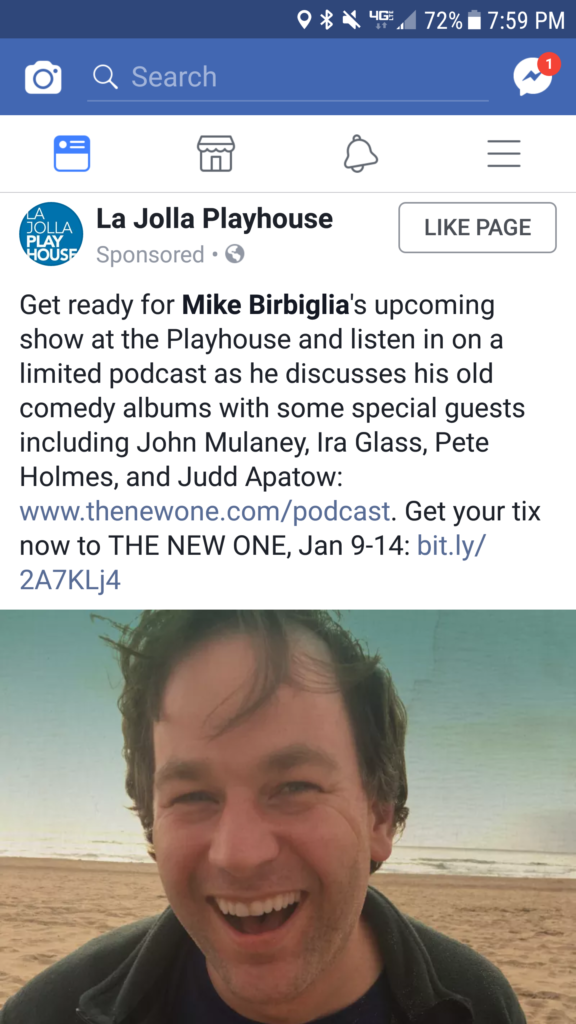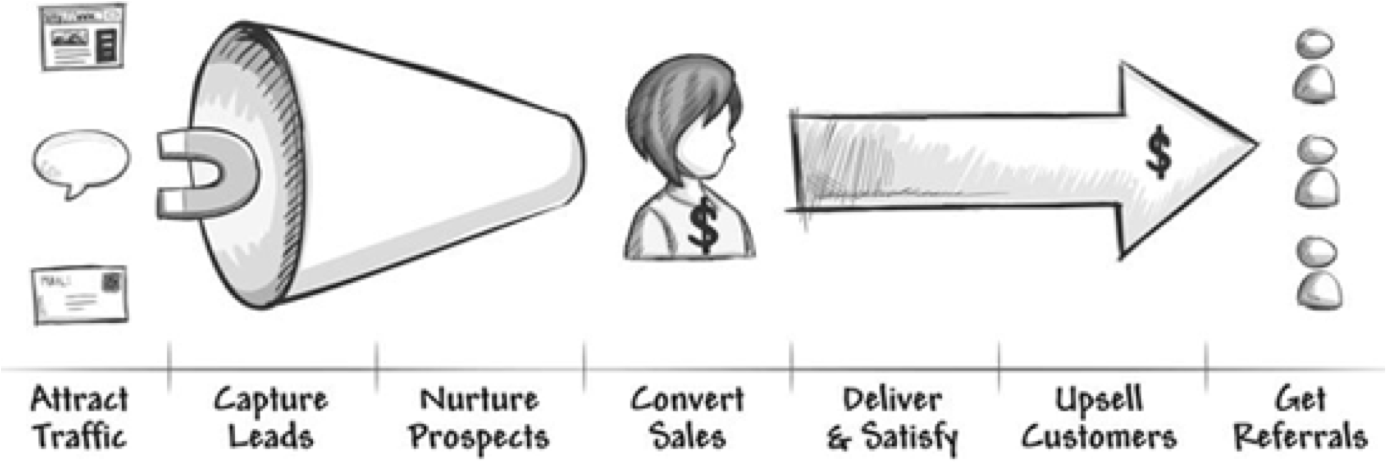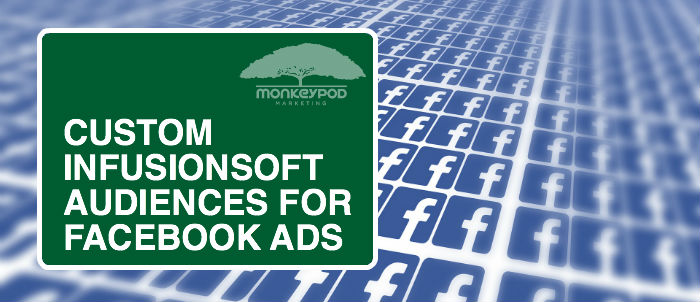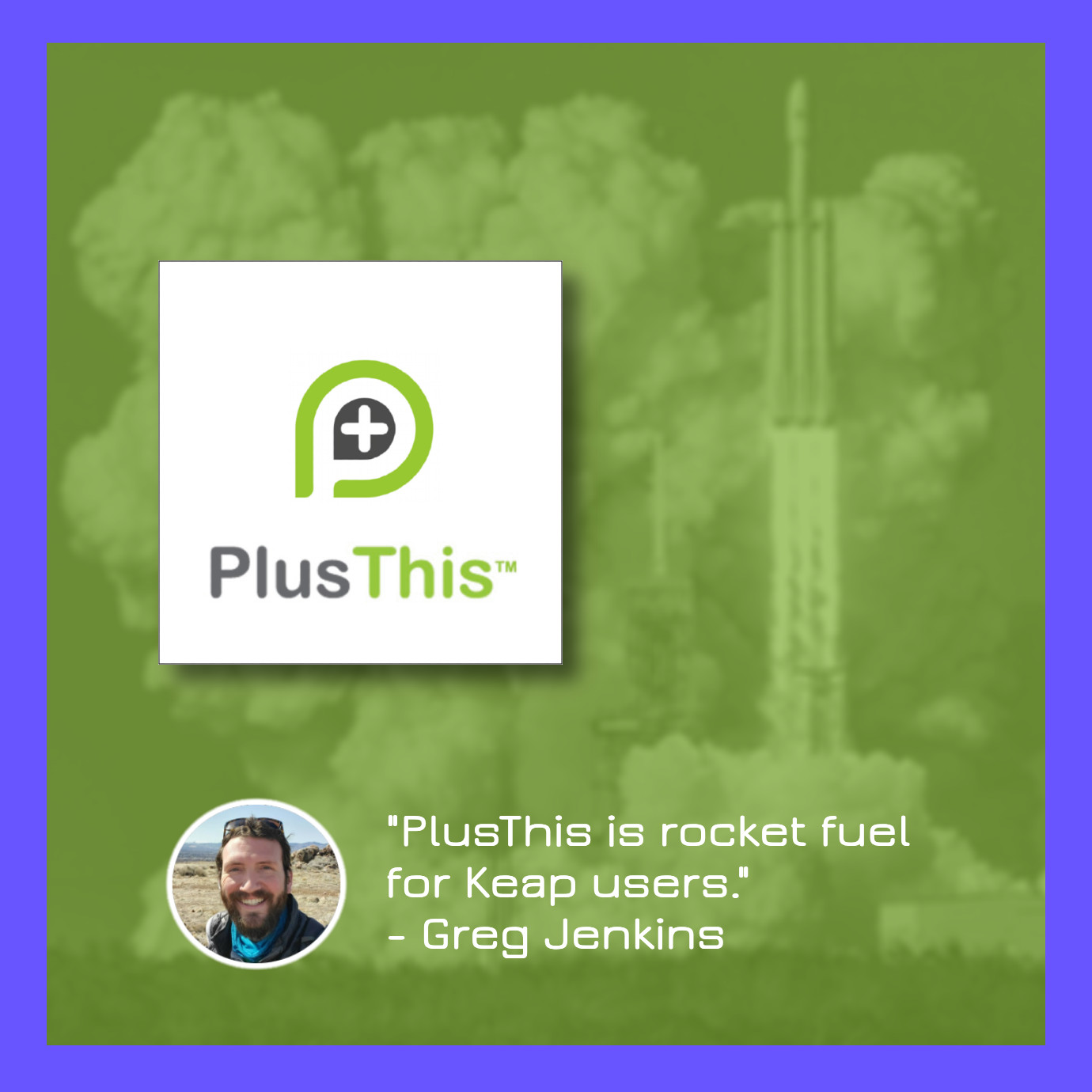So the other day I was looking at buying tickets for an upcoming Mike Birbiglia performance at the La Jolla Playhouse, and around the same time, I started seeing Facebook Ads promoting the show.
No big deal, I’m being re-targeted, right?

I think most of us are familiar with that concept – it’s when you visit a web page, and then ads like this one follow you around the internet (in this case, around Facebook).
So, I bought my tickets for the show, and the very next day I saw a new ad from the La Jolla Playhouse.
“Get ready for…”
I read it and the marketer in me immediately starting thinking “Cool, they must have one set of ads promoting the show, and then once you buy tickets, you start seeing this other set to help build excitement and promote his podcast.”
Once I got to the closing CTA and noticed it was still asking me to buy tickets, I was disappointed to realize they weren’t running a different set of ads to the people who already bought.
But they could be.
I don’t know what systems they use to collect and process payments, so this might not work for everyone; but if you use Keap and you advertise on Facebook, then this can work for you.
Think about your perfect customer journey – it might look something like this:

You drive traffic to some sort of opt-in, you deliver on your lead magnet, provide value, build rapport, convert prospects to customers, fulfill on your products and services, and then collect testimonials, ascend, repeat, etc – right?
And so if this is the progression we want people to take, the path we hope they’ll follow, what happens if they don’t?
What’s our safety net if they don’t do what we want them to do. What happens to the people who stall out?
The most common answer, especially with Keap, is email. We can use tactics like the Infusionsoft Nudge, or Abandon Cart campaigns as contingency plans.

And it works, I use both of those successfully in my own business.
But email is just one channel of communication – and for some audiences, or industries, it’s not the most effective channel.
So the question becomes “What channels, outside of email, could we use to help our prospects navigate this journey?”
And there are many, SMS solutions are as popular as ever, Facebook Messenger Bots are becoming more and more mainsteam; and, Facebook Ads.
The concept is relatively simple. At the highest level we’re talking about using Facebook Ads to reinforce whatever message we’re delivering to the customer at the point in their journey we’re at.
Our ads can align with our funnel and help promote or suggest whatever the next logical action would be.

The shift for most people is that we’ve been trained to think about Facebook Ads as tools for Lead Generation, or even conversion tools.
But if we shed those imaginary rules, and we think about Facebook Ads as simply another way to deliver a message, using them to echo or emphasize what we’re already saying starts to make a lot of sense.
How does it work?
In order for this to work, Facebook needs to know where people are in your funnel. You’ll want to connect your Facebook Ads account to Keap so that you can automatically sync contacts through into custom audiences.
There are a few ways to do this, but basically it’d mean identifying segments of the customer journey where you could use a Facebook Ad to improve to enhance the existing experience your prospects have.
What tools do I need?
There are a few options for tools to connect your Keap account and your Facebook Account. I’m sure there are several others, but one we use is PlusThis.
PlusThis offers a tool called Facebook Audience Triggers – which is simple to set up, and really flexible. The tool allow you to add or remove contacts from a Facebook Custom Audience by running an HTTP post as a step in any of your automations.
If you don’t want to use PlusThis, you can also look at Zapier or MyFusionHelper as alternatives. With any of these options you could set up Ad sets to target a particular audience and know that your contacts will only see that add when it’s relevant for them, because they’re only part of the audience when it makes sense for them.
What else?
Listen, I’m no FacebookAds expert – that’s for sure. But this concept has been swirling around the ecosystem for a few years now, and it’s worth a look if you run a lot of Facebook Ads, or deal with a large volume of traffic.
This CAN work for smaller businesses and lists as well, but I’ve found that the ability to match contacts from your database to their Facebook profile is only about 65% accurate. So, if you’ve got a list of 10000 in Keap, you can expect it to find about 6500 for your corresponding Facebook audience.
I won’t make assumptions about your business, but to me this feels like something that everyone COULD be doing in one way or another (even you La Jolla Playhouse).
If you’ve got a different spin on this, questions about it, or your own success story to share, please feel free to do so below!





Hey, Greg! I’d say the best bet is to rely on facebook pixel. Of course it might not work with all the steps in the customer journey, but most of the times, our customer will visit some page that has the facebook pixel installed on.
And if that’s the case, then all we have to do is to retarget a custom audience based on that pixel. And that audience is updated by Facebook, we do not run the risk of not matching e-mails.
Perfect. Makes total sense. 🙂
Hey Felipe,
Correct but I’ve found that a lot of Infusionsoft users have some or all of their business transactions offline so you need to use CRM data to really do funnel retargeting as described.
Also, I don’t don’t like to rely only on the pixel and in most cases the pixel data is only good for up to 180 days.
I like to exclude both pixel audiences and custom audiences to ensure the right people see the right ad, at the right time, all the time, automatically. It gives you better control to use the pixel and customer list custom audiences together.
Lastly, many businesses have data that goes back years. They’ve spent time, money, and energy collecting that data and using a platform like SyncSumo to get that data into Facebook is priceless.
Great post Greg!
Great points Justin – you’re the man!
That’s a great article. It would be really neat to see a video (or videos) where you and they work through an example (at a slow pace). I subscribed to one of those providers but found it overwhelming.
Great post Greg!
Thanks homie! And thanks for reading.
Great tips and love the post.
Thanks Bryce! Appreciate all you guys do.